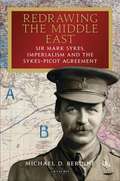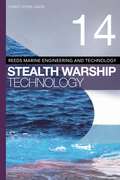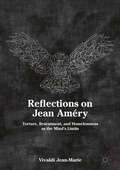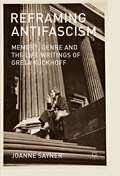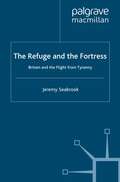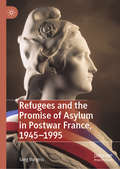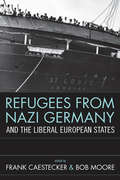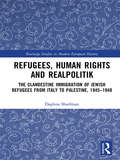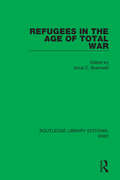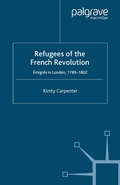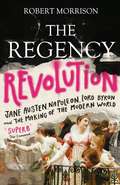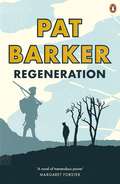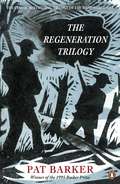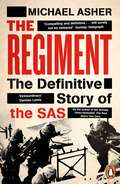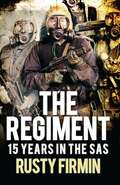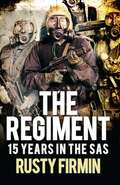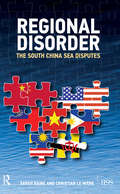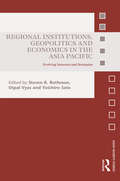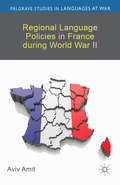- Table View
- List View
Redrawing the Middle East: Sir Mark Sykes, Imperialism and the Sykes-Picot Agreement (Library of Middle East History)
by Michael D. BerdineThe Sykes–Picot agreement was one of the defining moments in the history of the modern Middle East. Yet its co-creator, Sir Mark Sykes, had far more involvement in British Middle East strategy during World War I than the agreement for which he is now most remembered. Between 1915 and 1916, Sykes was Lord Kitchener's agent at home and abroad, operating out of the War Office until the war secretary's death at sea in 1916. Following that, from 1916 to 1919 he worked at the Imperial War Cabinet, the War Cabinet Secretariat and, finally, as an advisor to the Foreign Office. The full extent of Sykes's work and influence has previously not been told. Moreover, the general impression given of him is at variance with the facts. Sykes led the negotiations with the Zionist leadership in the formulation of the Balfour Declaration, which he helped to write, and promoted their cause to achieve what he sought for a pro-British postwar Middle East peace settlement, although he was not himself a Zionist. Likewise, despite claims that he championed the Arab cause, there is little proof of this other than general rhetoric mainly for public consumption. On the contrary, there is much evidence he routinely exhibited a complete lack of empathy with the Arabs. In this book, Michael Berdine examines the life of this impulsive and headstrong young British aristocrat who helped formulate many of Britain's policies in the Middle East – policies that are responsible for much of the instability that has affected the region ever since.
Reeds Vol 14: Stealth Warship Technology (Reeds Marine Engineering and Technology Series)
by Christopher LaversFirst book to give an insight into a growing area of interest - stealth warship technology - which is crucial for future developments in warship construction. It demonstrates the importance of materials used in warship construction and how this influences all of a naval platform's design parameters. Stealth technology is now considered a critical component within warship design, with interest in the concept of stealth increasing around the globe as naval forces adapt to new challenges. Many new developing nations are now implementing their first generation of stealth technology military hardware. This exciting book explores the full extent of threats to warships and thus the transformational change in naval architecture to incorporate these modern stealth technologies. Discussing the history of stealth technology, with references to well-known aircraft, ships and events in military history, the book also provides readers with a unique opportunity to develop an understanding of the specialist skills required in this naval sector. This is an essential read for anyone interested in stealth design and the issues involved in this evolving technology.
Reflections on Jean Améry: Torture, Resentment, and Homelessness as the Mind’s Limits
by Vivaldi Jean-MarieThis book elaborates Jean Améry’s critique of philosophy and his discussion of some central philosophical themes in At the Mind’s Limits and his other writings. It shows how Améry elaborates the shortcomings and unfitness of philosophical theories to account for torture, the experience of homelessness, and other indignities, and their inability to assist with overcoming resentment. It thus teases out the philosophical import of Jean Améry's critique of philosophy, which constitutes his own philosophical testament of being an inmate at Auschwitz. This book situates At the Mind’s Limits in the context of twentieth-century Continental philosophy. On the one hand, it elaborates Améry’s engagement with key philosophical figures. On the other hand, it shows how thoroughly Améry denounces the limits of the philosophical enterprise, and its impotence in capturing and accounting for the crimes of the Third Reich.
Reframing Antifascism: Memory, Genre and the Life Writings of Greta Kuckhoff
by J. SaynerGreta Kuckhoff belonged to the anti-Nazi group, 'The Red Orchestra'. She survived the War and spent the next thirty years working to commemorate their resistance. Using previously unpublished sources, this book traces the interventions of this key figure and raises provocative questions about remembering antifascism in contemporary Germany.
The Refuge and the Fortress: Britain and the Flight from Tyranny
by J. SeabrookIn the 75th anniversary of CARA (Council for Assisting Refugee Academics), this book explores the experiences and achievements of refugee academics and their rescuers to recount Britain's past relationship with overseas victims of persecution, and as vital questions about our present-day attitudes towards immigration and asylum.
Refugees and the Promise of Asylum in Postwar France, 1945–1995
by Greg BurgessThis book recounts France’s responses to refugees from the liberation of Paris in 1944 to the end of the civil wars in the former Yugoslavia in 1995. It questions whether France fulfilled the promise of asylum for those persecuted for the ‘cause of liberty’ made in its Constitution of 1946. Post-war development and the demand for immigrant workers were favourable to refugees from the Communist east, from Franco’s Spain, from Hungary after insurrection of 1956, and later from Latin America and Indochina. Asylum developed nationally in conjunction with international developments, the interventions of the United Nations High Commissioner for Refugees, and the adoption of the 1951 Refugee Convention. Economic ruptures in the 1970s, however, and the appearance of refugees from Asia and Africa, led to the assertion of national priorities and brought about a sense of crisis, and questions about whether France could continue to fulfil its promise.
Refugees From Nazi Germany and the Liberal European States
by Frank Caestecker Bob MooreThe exodus of refugees from Nazi Germany in the 1930s has received far more attention from historians, social scientists, and demographers than many other migrations and persecutions in Europe. However, as a result of the overwhelming attention that has been given to the Holocaust within the historiography of Europe and the Second World War, the issues surrounding the flight of people from Nazi Germany prior to 1939 have been seen as Vorgeschichte (pre-history), implicating the Western European democracies and the United States as bystanders only in the impending tragedy. Based on a comparative analysis of national case studies, this volume deals with the challenges that the pre-1939 movement of refugees from Germany and Austria posed to the immigration controls in the countries of interwar Europe. Although Europe takes center-stage, this volume also looks beyond, to the Middle East, Asia and America. This global perspective outlines the constraints under which European policy makers (and the refugees) had to make decisions. By also considering the social implications of policies that became increasingly protectionist and nationalistic, and bringing into focus the similarities and differences between European liberal states in admitting the refugees, it offers an important contribution to the wider field of research on political and administrative practices.
Refugees, Human Rights and Realpolitik: The Clandestine Immigration of Jewish Refugees from Italy to Palestine, 1945-1948 (Routledge Studies in Modern European History)
by Daphna SharfmanThis book presents a multidimensional case study of international human rights in the immediate post-Second World War period, and the way in which complex refugee problems created by the war were often in direct competition with strategic interests and national sovereignty. The case study is the clandestine immigration of Jewish refugees from Italy to Palestine in 1945–1948, which was part of a British–Zionist conflict over Palestine, involving strategic and humanitarian attitudes. The result was a clear subjection of human rights considerations to strategic and political interests.
Refugees, Human Rights and Realpolitik: The Clandestine Immigration of Jewish Refugees from Italy to Palestine, 1945-1948 (Routledge Studies in Modern European History)
by Daphna SharfmanThis book presents a multidimensional case study of international human rights in the immediate post-Second World War period, and the way in which complex refugee problems created by the war were often in direct competition with strategic interests and national sovereignty. The case study is the clandestine immigration of Jewish refugees from Italy to Palestine in 1945–1948, which was part of a British–Zionist conflict over Palestine, involving strategic and humanitarian attitudes. The result was a clear subjection of human rights considerations to strategic and political interests.
Refugees in the Age of Total War (Routledge Library Editions: WW2 #26)
by Anna C. BramwellThis book, first published in 1988, charts society’s responses to the huge numbers of refugees in Europe and the Middle East during and after the Second World War. At the close of the war large areas of Europe lay in ruins, and large numbers of refugees faced upheaval and famine. Political considerations influenced the decisions as to who received assistance, and refugees were forcibly repatriated or resettled – and in the analysis of these matters and more, both the refugee crises of the 1940s and their relevance today are highlighted.
Refugees in the Age of Total War (Routledge Library Editions: WW2 #26)
by Anna C. BramwellThis book, first published in 1988, charts society’s responses to the huge numbers of refugees in Europe and the Middle East during and after the Second World War. At the close of the war large areas of Europe lay in ruins, and large numbers of refugees faced upheaval and famine. Political considerations influenced the decisions as to who received assistance, and refugees were forcibly repatriated or resettled – and in the analysis of these matters and more, both the refugee crises of the 1940s and their relevance today are highlighted.
Refugees of the French Revolution: Émigrés in London, 1789–1802
by K. CarpenterKirsty Carpenter puts a human face on the victims of revolutionary legislation. London had the largest community of émigrés. It had the most evolved social structure and was the most politically-active community. It was in London that two cultures came face-to-face with their prejudices and were forced to confront them.
Regency Rebels: The Soldier's Dark Secret (comrades In Arms) / The Soldier's Rebel Lover (Mills And Boon M&b Ser.)
by Marguerite KayeHidden truths
The Regency Revolution: Jane Austen, Napoleon, Lord Byron and the Making of the Modern World
by Robert Morrison'Superb' The Economist'Elegant, entertaining and frequently surprising' New York TimesThe fascinating story of the Regency period in Britain - an immensely colourful and chaotic decade that marked the emergence of the modern world.The Regency began on 5 February 1811 when the Prince of Wales replaced his violently insane father George III as the sovereign de facto. It ended on 29 January 1820, when George III died and the Prince Regent became King as George IV. At the centre of the era is of course the Regent himself, who was vilified by the masses for his selfishness and corpulence. Around him surged a society defined by brilliant characters, momentous events, and stark contrasts; a society forced to confront a whole range of pressing new issues that signalled a decisive break from the past and that for the first time brought our modern world clearly into view.The Regency Revolution is the most thorough and vivid exploration of the period ever published, and it reveals the remarkably diverse ways in which the cultural, social, technological and political revolutions of this decade continue both to inspire and haunt our world.
Regeneration (Regeneration #1)
by Pat BarkerA Hay Festival and The Poole VOTE 100 BOOKS for Women SelectionThe modern classic of contemporary war fiction - a Man Booker Prize-nominated examination of World War I and its deep legacy of human traumas.'A brilliant novel. Intense and subtle' Peter Kemp, Sunday TimesCraiglockhart War Hospital, Scotland, 1917, and army psychiatrist William Rivers is treating shell-shocked soldiers. Under his care are the poets Siegfried Sassoon and Wilfred Owen, as well as mute Billy Prior, who is only able to communicate by means of pencil and paper. Rivers's job is to make the men in his charge healthy enough to fight. Yet the closer he gets to mending his patients' minds the harder becomes every decision to send them back to the horrors of the front. Pat Barker's Regeneration is the classic exploration of how the traumas of war brutalised a generation of young men.This is the first novel in Pat Barker's Man Booker Prize-winning Regeneration Trilogy:I: RegenerationII: The Eye in the DoorIII: The Ghost Road'A vivid evocation of the agony of the First World War and a multi-layered exploration of all wars. A fine anthem for doomed youth' Time Out'A novel of tremendous power' Margaret Forster 'Unforgettable' Sunday Telegraph'One of the strongest and most interesting novelists of her generation' Guardian
The Regeneration Trilogy: Regeneration; The Eye In The Door; The Ghost Road (The\wwi Trilogy Ser. #1)
by Pat BarkerThe Regeneration Trilogy is Pat Barker's sweeping masterpiece of British historical fiction. 1917, Scotland. At Craiglockhart War Hospital in Scotland, army psychiatrist William Rivers treats shell-shocked soldiers before sending them back to the front. In his care are poets Siegfried Sassoon and Wilfred Owen, and Billy Prior, who is only able to communicate by means of pencil and paper. . .Regeneration, The Eye in the Door and The Ghost Road follow the stories of these men until the last months of the war. Widely acclaimed and admired, Pat Barker's Regeneration trilogy paints with moving detail the far-reaching consequences of a conflict which decimated a generation.'Harrowing, original, delicate and unforgettable' Independent'A new vision of what the First World War did to human beings, male and female, soldiers and civilians. Constantly surprising and formally superb' A. S. Byatt, Daily Telegraph'One of the few real masterpieces of late twentieth-century British fiction' Jonathan CoePat Barker was born in 1943. Her books include the highly acclaimed Regeneration trilogy, comprising Regeneration (1991); which was made into a film of the same name; The Eye in the Door (1993), which won the Guardian Fiction Prize; and The Ghost Road (1995), which won the Booker Prize, as well as the more recent novels Another World, Border Crossing, Double Vision, Life Class and Toby's Room. She lives in Durham.
The Regiment: The Real Story of the SAS
by Michael AsherOn 4 May 1980, seven terrorists holding twenty-one people captive in the Iranian Embassy in London’s Prince’s Gate, executed their first hostage. They threatened to kill another hostage every thirty minutes until their demands were met. Minutes later, armed men in black overalls and balaclavas shimmied down the roof on ropes and burst in through windows and doors. In seconds all but one of the terrorists had been shot dead, the other captured.For most people, this was their first acquaintance with a unit that was soon to become the ideal of modern military excellence – the Special Air Service regiment. Few realized that the SAS had been in existence for almost forty years, playing a discreet, if not secret, role almost everywhere Britain had fought since World War II, and had been the prototype of all modern special forces units throughout the world.In The Regiment, Michael Asher – a former soldier in 23 SAS Regiment – examines the evolution of the special forces idea and investigates the real story behind the greatest military legend of the late twentieth century.
The Regiment: 15 Years in the SAS
by Rusty FirminFrom its early beginnings in World War II, the Special Air Service (SAS) has won renown in some of the most dramatic, dangerous and controversial military special operations of the 20th century. It is a secretive and mysterious unit, whose operations and internal structures are hidden from the public eye. Now, one of its longest-serving veterans offers a glimpse into the shadowy world of the SAS. Rusty Firmin spent an incredible 15 years with 'The Regiment' and was a key figure in the assault of the Iranian Embassy in London in May 1980. Newly revised and available in paperback, this is the unforgettable chronicle of Rusty's combat experiences – a fascinating and intimate portrayal of what it was like to be part of the world's most respected Special Operations Force.
The Regiment: 15 Years In The Sas
by Rusty FirminFrom its early beginnings in World War II, the Special Air Service (SAS) has won renown in some of the most dramatic, dangerous and controversial military special operations of the 20th century. It is a secretive and mysterious unit, whose operations and internal structures are hidden from the public eye. Now, one of its longest-serving veterans offers a glimpse into the shadowy world of the SAS. Rusty Firmin spent an incredible 15 years with 'The Regiment' and was a key figure in the assault of the Iranian Embassy in London in May 1980. Newly revised and available in paperback, this is the unforgettable chronicle of Rusty's combat experiences – a fascinating and intimate portrayal of what it was like to be part of the world's most respected Special Operations Force.
Regimes of Twentieth-Century Germany: From Historical Consciousness to Political Action
by Marc T. VossRegimes of Twentieth-Century Germany is a concise theory of and empirical study on action consciousness as an integral dimension of historical consciousness with specific emphasis on National Socialist Germany and the German Democratic Republic.
Regional Disorder: The South China Sea Disputes (Adelphi series)
by Sarah RaineChina‘s rise casts a vast and uncertain shadow over the regional balance of power in the Asia Pacific, and nowhere is this clearer than in the South China Sea. The significance of the fraught territorial disputes in this potentially resource-rich sea extends far beyond the small groupings of islands that are at their heart, and into the world of great-power politics. As the struggle for hegemony between the US and China intersects with the overlapping aspirations of emerging, smaller nations, the risk of escalation to regional conflict is real. Christian Le Mi and Sarah Raine cut through the complexities of these disputes with a clear-sighted, and much-needed, analysis of the assorted strategies deployed in support of the multiple and competing claims in the SCS. They make a compelling case that the course of these disputes will determine whether the regional order in Southeast Asia is one of cooperation, or one of competition and even conflict.
Regional Disorder: The South China Sea Disputes (Adelphi series)
by Sarah RaineChina‘s rise casts a vast and uncertain shadow over the regional balance of power in the Asia Pacific, and nowhere is this clearer than in the South China Sea. The significance of the fraught territorial disputes in this potentially resource-rich sea extends far beyond the small groupings of islands that are at their heart, and into the world of great-power politics. As the struggle for hegemony between the US and China intersects with the overlapping aspirations of emerging, smaller nations, the risk of escalation to regional conflict is real. Christian Le Mi and Sarah Raine cut through the complexities of these disputes with a clear-sighted, and much-needed, analysis of the assorted strategies deployed in support of the multiple and competing claims in the SCS. They make a compelling case that the course of these disputes will determine whether the regional order in Southeast Asia is one of cooperation, or one of competition and even conflict.
Regional Institutions, Geopolitics and Economics in the Asia-Pacific: Evolving Interests and Strategies (Asian Security Studies)
by Steven B. Rothman Utpal Vyas Yoichiro SatoThis volume discusses the relationship between economics, geopolitics and regional institutional growth and development in the Asia-Pacific region. How do states (re)define their relationships amid the current global power transition? How do rival actors influence the rules and formation of new institutions for their own benefit? What role will institutions take as independent actors in influencing and constraining the behavior of states? Institutional development in Asia is characterized by idiosyncratic and diverse motivations (both material and non-material), a variety of policy strategies (strategic and norm-based), and the looming question of China’s future depth of involvement as its economic position becomes more stable and its confidence in foreign affairs grows. The book reflects the broadening definition of Asia by examining multiple perspectives, including Japan, China, South Korea, the United States, Australia, India, Russia, and Taiwan. In addition to state actors, the contributors address several important regional institutions in development such as the ASEAN (+3, +6, and the East Asian Summit), the Asian Infrastructure Investment Bank (AIIB), the Asian Development Bank (ADB), existing security alliances, and other bilateral institutions. Ultimately, this volume describes the unique, slow, and diverse growth of a multitude of regional institutions, the complexities of generating cooperation, membership concerns, and competition between states and with existing institutions in the context of China’s increasing confidence and strength. This book will be of much interest to students of Asian politics, regional security, international organizations, and foreign policy.
Regional Institutions, Geopolitics and Economics in the Asia-Pacific: Evolving Interests and Strategies (Asian Security Studies)
by Steven B. Rothman Utpal Vyas Yoichiro SatoThis volume discusses the relationship between economics, geopolitics and regional institutional growth and development in the Asia-Pacific region. How do states (re)define their relationships amid the current global power transition? How do rival actors influence the rules and formation of new institutions for their own benefit? What role will institutions take as independent actors in influencing and constraining the behavior of states? Institutional development in Asia is characterized by idiosyncratic and diverse motivations (both material and non-material), a variety of policy strategies (strategic and norm-based), and the looming question of China’s future depth of involvement as its economic position becomes more stable and its confidence in foreign affairs grows. The book reflects the broadening definition of Asia by examining multiple perspectives, including Japan, China, South Korea, the United States, Australia, India, Russia, and Taiwan. In addition to state actors, the contributors address several important regional institutions in development such as the ASEAN (+3, +6, and the East Asian Summit), the Asian Infrastructure Investment Bank (AIIB), the Asian Development Bank (ADB), existing security alliances, and other bilateral institutions. Ultimately, this volume describes the unique, slow, and diverse growth of a multitude of regional institutions, the complexities of generating cooperation, membership concerns, and competition between states and with existing institutions in the context of China’s increasing confidence and strength. This book will be of much interest to students of Asian politics, regional security, international organizations, and foreign policy.
Regional Language Policies in France during World War II (Palgrave Studies in Languages at War)
by A. AmitDuring Germany's occupation of France in WWII, French regional languages became a way for people to assert their local identities. This book offers a detailed historical sociolinguistic analysis of the various language policies applied in France's regions (Brittany, Southern France, Corsica and Alsace) before, during and after WWII.
